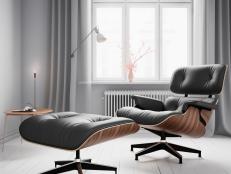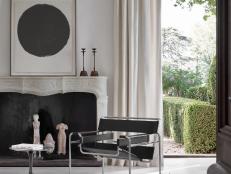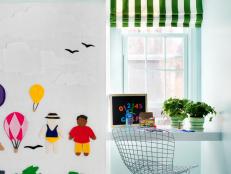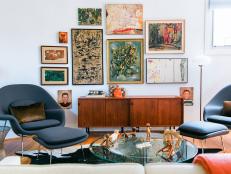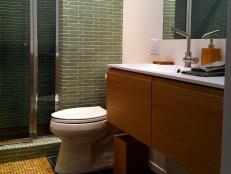Trending Now: Arne Jacobsen’s Egg Chair
Conceived as seating for the jet set in an iconic Copenhagen hotel, this curvaceous Danish modern beauty is a midcentury (and much-copied) classic. Here’s the story of how it hatched.

The SAS Royal Hotel opened its doors in downtown Copenhagen in July of 1960. The city’s first skyscraper and “the world’s first design hotel,” it was an instantly-celebrated gesamtkunstwerk (“total work of art”): from the 22-story structure itself on down to the cutlery guests used to dine in its public spaces, every element of the hotel’s design was conceived by Copenhagen native Arne Jacobsen.

Fritz Hansen
Arne Jacobsen's Egg Chair: One of the midcentury's most recognizable (and possibly most copied) Danish modern masterpieces.
Born in Copenhagen in 1902, Jacobsen is said to have dreamed of becoming a painter (and to have succumbed to family pressure to pursue a more practical vocation). After a spell of apprenticeship to a stonemason, he became an architecture student at the historic and prestigious Royal Danish Academy of Fine Arts.
Fame found him before he’d officially graduated: in 1925, at the tender age of 23, he won a silver medal for his chair design at the Exposition Internationale des Arts Décoratifs et Industriels Modernes (that is, the Parisian fair that went on to give the Art Deco movement its name). Shortly after graduation, in turn, he and former architecture schoolmate Flemming Lassen won a competition to design a spectacular House of the Future. That building was considered one of the first major examples of Functionalist architecture (based on the principle that a building’s design should be based on its purpose and function alone), and it launched Jacobsen’s career.

Fritz Hansen
By the time Jacobsen established his own firm in 1930, his reputation as a rising star in contemporary architecture was substantial. His influential, ultra-modern style gained him admiration in his industry but divided the general public: when his steel-and-concrete Stellings Hus was completed in Copenhagen’s oldest square in 1937, it caused such a public outcry that a local journalist argued that he should be “banned from architecture for life.”
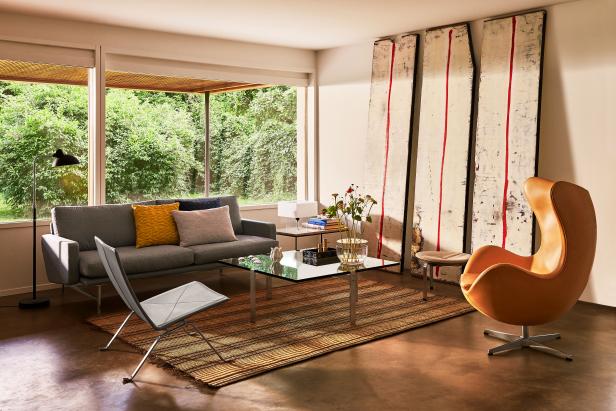
Fritz Hansen
That sentiment didn’t gain much traction in the design world, thankfully, and Jacobsen continued to populate Copenhagen and other western European cities with his futuristic creations — until World War II, when he was forced to relocate to Sweden to escape deportation as a Danish citizen of Jewish heritage. The war both hampered his ability to create new buildings — materials for civilian projects were few and far between, and commissions were even scarcer — and redirected his design focus to interior projects like fabric and wallpaper design. When the Allies were victorious and he was able to return to his homeland, he resumed his architectural practice and returned to the furniture design that had earned him his first accolades. In 1952, a commission for a pharmaceutical company gave rise to the Ant™ chair, his first now-classic piece; three years later, a variation called the Series 7™ chair debuted (and would go on to become the most popular chair he ever designed).

Little wonder, then, that Scandinavian Airline Systems (SAS) turned to Jacobsen to dream up a high-profile urban hotel that would feature an air terminal, cater to their high-flying, well-heeled customers and serve as a calling card for their company. The building he created was recognized then and now as a spectacular exemplum of Danish modernism; his efforts to embellish its interior, in turn, yielded three iconic chair designs. His favorite, the Drop™ chair, was produced in a site-specific run of just 200; it remained unavailable to the public until 2014, when it was offered for sale for the first time. The swooping, social-butterfly-friendly Swan™ chair he designed in his garage for the hotel’s lounge and lobby has been in continuous production through Fritz Hansen, its originator, since its creation.

Fritz Hansen
As for the magnificent Egg™ chair — which owes its enveloping curves to the sturdy foam shell Jacobsen developed to provide cushioning beneath the piece’s exterior material — well, it provided a cocooning effect that counterbalanced the no-nonsense structure of the skyscraper that surrounded it. Weighing in at just 17 pounds, the swiveling, reclining chair was (and is) easy to move; upholstered so precisely that its seams are virtually invisible, it’s a clean, luxurious piece that turned heads at the hotel (in an initial run of 50) and went on to become what could be the most recognizable (and is certainly one of the most copied) chairs of all time.

Acquiring an Egg™ chair of one’s own has always been a costly proposition: six decades ago and in all the years since, the real deal is an aspirational piece (which now costs $7,000 and up). That exclusivity is bound up in skilled craftsmanship — because the training required to fit the chair’s exterior material to its polyurethane base is so specialized, a mere handful of the chairs are produced in Denmark each week — and a mystique that its originators hoped to cultivate when it was initially made available. To know that the chair you’re examining is authentic, you can certainly check for serial numbers and identifying labels; you can also have a look at the chair’s back (which should never have a seam), its arms (which must have characteristic zigzag stitching) and its base (which always has four feet).

Scott McDonald, Hedrich Blessing
Design buffs who’d fancy taking a load off in one of Jacobsen’s original creations in their natural habitat might be disappointed, technically speaking. Now known as the Radisson Royal Collection Copenhagen, the hotel boasts just one space — guest room 606 — that looks as it did on opening day in 1960. That said, the property’s 2018 renovation took its interior design back to its midcentury roots, and it now boasts Jacobsen’s classic chairs in all-new colors. They share space with another original creation: Bindslev Henriksen and Peter Bundgaard Rützou’s Loafer chair, designed to add another chapter to the hotel’s design story. We imagine they’ll live happily ever after.
Mid-Mod Style Guide: 15 Iconic Scandinavian Chairs 16 Photos
Meet the midcentury modern classics that are the little black dress of decor. These curvy, minimalist masterpieces come from a design tradition that originated in Nordic countries in the 1940s and rules the design world till this day.








